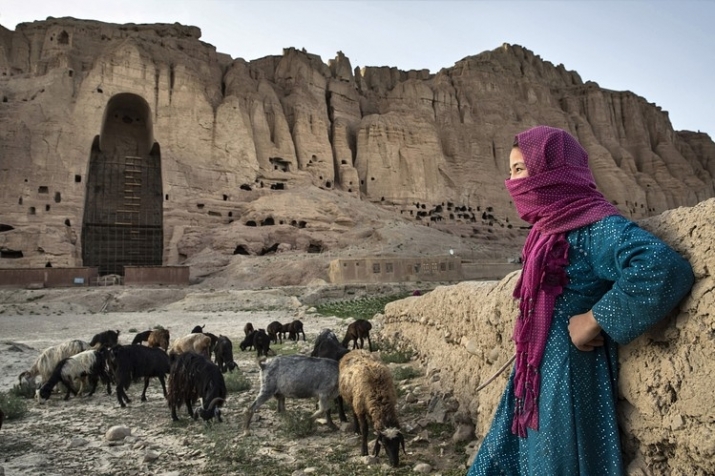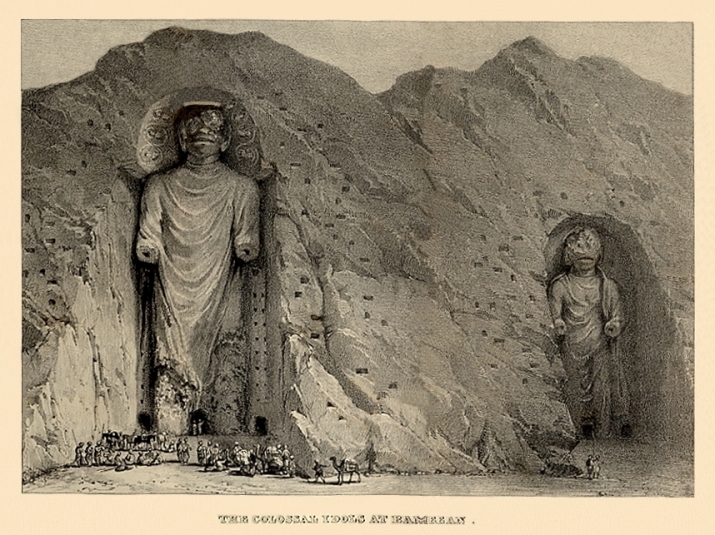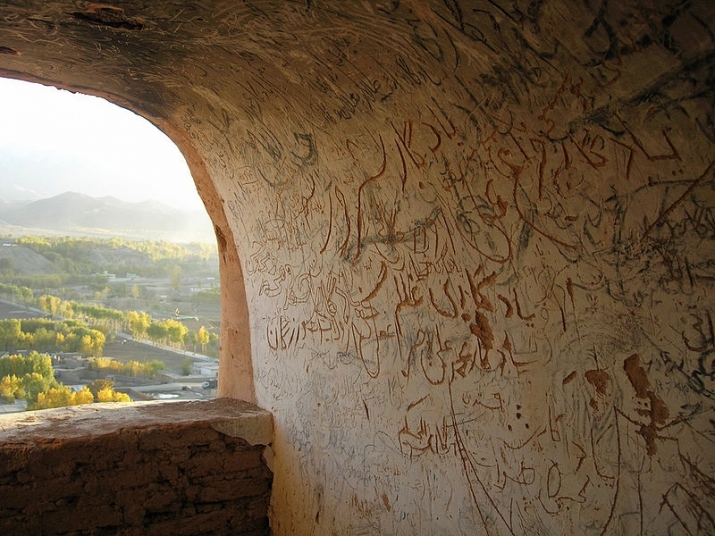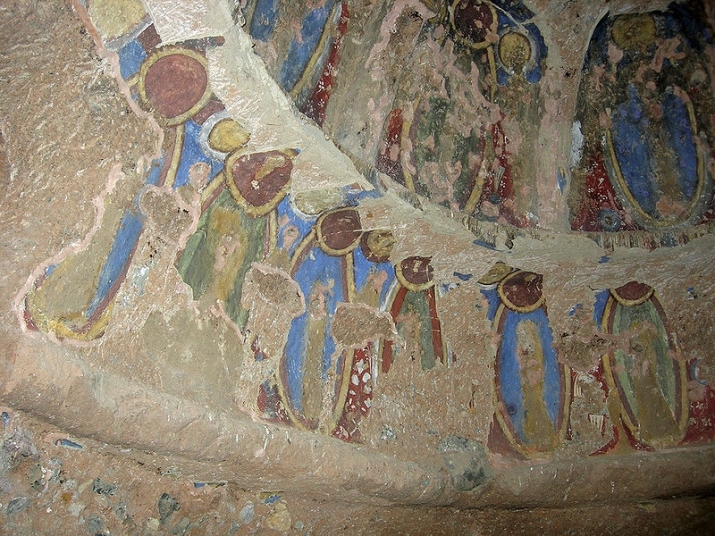FEATURES|THEMES|Commentary
Buddhistdoor View: The Case for Rebuilding the Bamiyan Buddhas to Their Original Glory
 A girl watches over her sheep and goats as they graze before one of the destroyed Bamiyan Buddhas. From wsj.com
A girl watches over her sheep and goats as they graze before one of the destroyed Bamiyan Buddhas. From wsj.comAfter a long and difficult journey across the precipices and through the blizzards of the Tian Shan mountain ranges, Xuanzang (fl. c. 602–64) finally reached the town of Bamiyan in modern-day Afghanistan. His celebrated pilgrimage to India was one of astonishing tenacity, aided by the protection of bodhisattvas from the forces of nature, and on this leg of his journey Xuanzang arrived in a valley separating the Hindu Kush from its western extension, the Koh-i-baba. The residents of Bamiyan, according to the Chinese monk, wore furs and rough woolen clothes, and made a living growing spring wheat, flowers, and fruit, and herding cows, horses, and sheep. The people had coarse, uncultivated manners, but Xuanzang admired their simple and sincere religious faith, which they expressed by carving two colossal Buddha images into the rocky northeastern hill overlooking their settlements (a third reclining Buddha recorded in Xuanzang’s journal has yet to be found).
It is not known when the affectionately bestowed nicknames for the larger Buddha, Salsal (“light shines throughout the universe”), and Shamama (“Queen Mother”) for the smaller image, came into use. Historian Mahmud ibn Wali of Balkh (b. c. 1004 or 1095) wrote in his hagiography Bahr al-Asrar: “One cannot believe that there were made by human hands.” Frédéric Bobin of Le Monde put it quite well: “For 15 centuries the two mystic colossi gazed down as the trading caravans and warring armies streamed past. Monks came from China to worship here. Others meditated in nearby caves.” (The Guardian) Until they were desecrated and destroyed by the Taliban in 2001, the Bamiyan Buddhas inspired Buddhist, Christian, and Muslim observers alike, with one mullah (who no doubt represented the tolerant Islamic community in Bamiyan) lamenting, “The statues symbolised Bamiyan.” (The Guardian)
The Alliance for the Restoration of Cultural Heritage (ARCH)* supports full restoration of the Bamiyan Buddhas and has carried out a rigorous study of eight options for rebuilding them. This is a proposal that makes many conservators at UNESCO blanch. It was UNESCO that declared in 2011 that the statues would be best remembered by their absence. “The two niches should be left empty, like two pages in Afghan history, so that subsequent generations can see how ignorance once prevailed in our country,” said Zamaryalai Tarzi, a Franco-Afghan archaeologist. (The Guardian) This is the dominant school of conservation at Bamiyan, which has been the victim of continuous political wrangling from different organizations and experts. Official UNESCO policy is based on the 1964 Venice Charter, which demands that “original material” be used for the conservation and restoration of monuments and sites, and if this rule is disregarded, there is the threat of UNESCO striking the site off its World Heritage List.
 The Colossal Idols at Bameean by Alexander Burnes, 1834, with dark incisions as caves. From columbia.edu
The Colossal Idols at Bameean by Alexander Burnes, 1834, with dark incisions as caves. From columbia.eduHowever, after a long dialogue with ARCH and consulting Professor S. Frederick Starr, a distinguished expert on Eurasian affairs and history, we also believe that there is a sound rationale for full restoration.
The hesitation to reconstruct the images betrays a Eurocentric prejudice that has dominated UNESCO for too long, and ARCH’s report argues that a full restoration of the Buddha images would go a long way to restoring the faith of many people in the organization’s professedly unbiased assessment protocol, such as that of Michael Petzet of the German branch of the International Council on Monuments and Sites (ICOMOS), who has made multiple statements in support of rebuilding at least Shamama. Lauren Bursey argued in 2014 that the Afghan administration felt that rebuilding the statues would be a symbolic triumph over the Taliban, and that Afghans saw not doing so as depriving future generations of the opportunity to see them.
The Eurocentric perspective is also evident in the priorities given to the nine criteria that UNESCO uses to determine a site or monument’s heritage value: design, material, workmanship, setting, traditions, techniques, language, intangible heritage, and spirit and feeling. The first three clearly betray a preference for “objectivity” based on the rationalist values of European art. At the end of the day, rationalism alone cannot reflect the non-material values of a Buddhist site: in Asia (the continent to which these carvings belonged before they were destroyed) building materials are often more transient, such as wood, unbaked clay, or stucco that formed the Buddhas’ robes.
The role of a locale for ritual purposes and its ties to antiquity or a meaningful event are much more important than the question of whether a commemorative or ritual structure, or its components, are “original.” While the Buddhas at Bamiyan were made primarily from stone, it is their location, in the heart of old Bactria and at the crossroads of civilizations such as the Hellenic world, old India, and China, that makes even the blasted cavities of the destroyed statues holy.
 A defaced cave overlooking the Bamiyan valley. From wikimedia.org
A defaced cave overlooking the Bamiyan valley. From wikimedia.orgAsian conservation philosophy focuses on the intangible significance of a site rather than material or tangible “stuff,” and the relationship between the landscape itself and the monument, while UNESCO’s approach focuses disproportionately on the latter. Indeed, one might say that this attitude has divorced the structures of the Buddhas from the site at which they were carved—and this is untenable from the Buddhist perspective, where the “spirit of the land” matters much more. Language, intangible heritage, and spirit and feeling were only added as UNESCO conservation categories in 2005.
The idea that the holiness (or even the restorability) of a historical monument or site has an endpoint, after which they should not be touched again, is arbitrary and unfair. It is not as if Europe’s most beloved heritage sites have not undergone extensive and large-scale restoration over the centuries. During the Second World War, German cities such as Dresden, Hanover, Worms, and many more were obliterated. In the immediate aftermath of the war, their historic buildings were piles of rubble, but today these structures, from neighborhoods to concert halls and cathedrals, have been unapologetically restored. Why should it not be the same for Buddhist structures, if the local community deems it desirable?
“I strongly support the idea of restoring the Buddhas to their original status,” Prof. Starr said when Buddhistdoor Global contacted him about the Bamiyan Buddhas. “This would be the best way to repudiate those who twice tried to destroy them—first in the 8th century and then again in the 20th century. They would stand as symbols of tolerance in modern Afghanistan.” A statement of Bamiyan’s broadmindedness would surely boost the cultural image of Afghanistan, where decades of political upheaval, economic difficulty, and foreign invasions have given it an unrepresentative image of cultural backwardness and Islamism. This enlightened attitude could even be said to be the “spirit” of Bamiyan, where few women wear burkas and 40 per cent of the girls are in school, the highest proportion in the country.
Finally, we should not overlook the considerable economic potential that restoring the Bamiyan Buddhas could represent. As recently as 2015, the South Asian Association for Regional Cooperation (SAARC) named it a capital of culture, a designation that did not amount to much at all, according to the Germany- and Afghanistan-based Afghanistan Analysts Network (AAN), an independent think-tank. This designation should have been accompanied by events such as photo and painting exhibitions, traditional musical performances, a handicrafts bazaar, a food show, a literary and film festival, and more. But according to AAN, the initiatives all failed due to regional instability, insecure roads, an undersized airport, and the inability to drum up adequate international interest. While it is truly dismaying that “none of the 40 or so promised development projects have been implemented” (Afghanistan Analysts Network), full restoration of the Buddhas could be an important contribution to the overall restoration and reform of Bamiyan’s infrastructure and potential as a cultural hub and an economic asset.
 Remnants of cave paintings in the monastic center of Bamiyan. From wikimedia.org
Remnants of cave paintings in the monastic center of Bamiyan. From wikimedia.orgConservators and international organizations should look at restoring the Bamiyan Buddhas through the rubrics of fidelity to Asian standards of conservation, the restoration of cultural pride for local residents, and the potential for a corresponding economic revival in the area. Just as the land itself should not be divorced from the restoration of a landmark or monument, the Buddhas should not be considered apart from the context of Bamiyan’s future and the flourishing of its resilient people.
* ARCH is a non-profit organization committed to the promotion and defense of culture marred by crisis and war. In addition to the Bamiyan Buddhas and other projects, it has devoted resources to saving Pavlopetri, an ancient underwater city in Greece, collaborating with other institutions to protect Syria’s heritage, and helping to design a garden as celebrated in Rumi’s poetry in Kabul University (akin to the Shakespeare Garden in the Brooklyn Botanical Garden).
See more
Disputes damage hopes of rebuilding Afghanistan’s Bamiyan Buddhas (The Guardian)
Conserving v. Rebuilding Afghanistan’s Bamiyan Buddhas (Center for Art Law)
Schon gewusst? Bamiyan ist Kulturhauptstadt 2015 (Welt)
Bamyan, First Ever Cultural Capital of South Asia: A big party, but what else? (Afghanistan Analysts Network)
Related features from Buddhistdoor Global
The Nostalgia of 2,500 Years: Celebrating South Asia’s Buddhist Heritage














